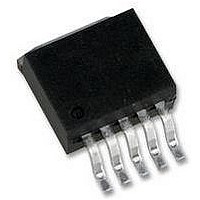LM2596S-12 National Semiconductor, LM2596S-12 Datasheet - Page 23

LM2596S-12
Manufacturer Part Number
LM2596S-12
Description
DC/DC Converter IC
Manufacturer
National Semiconductor
Specifications of LM2596S-12
Input Voltage
40V
Output Current
3A
Output Voltage
12V
No. Of Pins
5
Termination Type
SMD
Mounting Type
Through Hole
Voltage Regulator Type
Buck Switching
Output Current Max
3A
Lead Free Status / RoHS Status
Contains lead / RoHS non-compliant
Available stocks
Company
Part Number
Manufacturer
Quantity
Price
Part Number:
LM2596S-12
Manufacturer:
CG
Quantity:
20 000
Company:
Part Number:
LM2596S-12/NOPB
Manufacturer:
MICROCHIP
Quantity:
1 450
Application Information
but with copper areas greater than approximately 6 in
small improvements in heat dissipation are realized. If fur-
ther thermal improvements are needed, double sided, multi-
layer PC board with large copper areas and/or airflow are
recommended.
The curves shown in Figure 20 show the LM2596S (TO-263
package) junction temperature rise above ambient tempera-
ture with a 2A load for various input and output voltages. This
data was taken with the circuit operating as a buck switching
regulator with all components mounted on a PC board to
simulate the junction temperature under actual operating
conditions. This curve can be used for a quick check for the
approximate junction temperature for various conditions, but
be aware that there are many factors that can affect the junc-
tion temperature. When load currents higher than 2A are
used, double sided or multilayer PC boards with large cop-
per areas and/or airflow might be needed, especially for high
ambient temperatures and high output voltages.
For the best thermal performance, wide copper traces and
generous amounts of printed circuit board copper should be
used in the board layout. (One exception to this is the output
(switch) pin, which should not have large areas of copper.)
Large areas of copper provide the best transfer of heat
(lower thermal resistance) to the surrounding air, and moving
air lowers the thermal resistance even further.
Package thermal resistance and junction temperature rise
numbers are all approximate, and there are many factors
that will affect these numbers. Some of these factors include
board size, shape, thickness, position, location, and even
board temperature. Other factors are, trace width, total
printed circuit copper area, copper thickness, single- or
double-sided, multilayer board and the amount of solder on
the board. The effectiveness of the PC board to dissipate
heat also depends on the size, quantity and spacing of other
components on the board, as well as whether the surround-
ing air is still or moving. Furthermore, some of these compo-
nents such as the catch diode will add heat to the PC board
and the heat can vary as the input voltage changes. For the
inductor, depending on the physical size, type of core mate-
rial and the DC resistance, it could either act as a heat sink
taking heat away from the board, or it could add heat to the
board.
(Continued)
DS012583-34
2
, only
23
Capacitors
Inductor
Diode
PC board
Capacitors
Inductor
Diode
PC board
FIGURE 19. Junction Temperature Rise, TO-220
FIGURE 20. Junction Temperature Rise, TO-263
Circuit Data for Temperature Rise Curve
Circuit Data for Temperature Rise Curve
FIGURE 21. Delayed Startup
Through hole electrolytic
Through hole, Renco
Through hole, 5A 40V, Schottky
3 square inches single sided 2 oz. copper
(0.0028")
Surface mount tantalum, molded “D” size
Surface mount, Pulse Engineering, 68 µH
Surface mount, 5A 40V, Schottky
9 square inches single sided 2 oz. copper
(0.0028")
TO-263 Package (S)
TO-220 Package (T)
DS012583-36
DS012583-35
www.national.com













